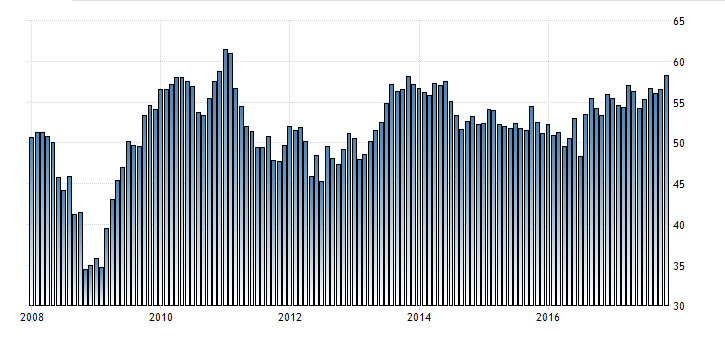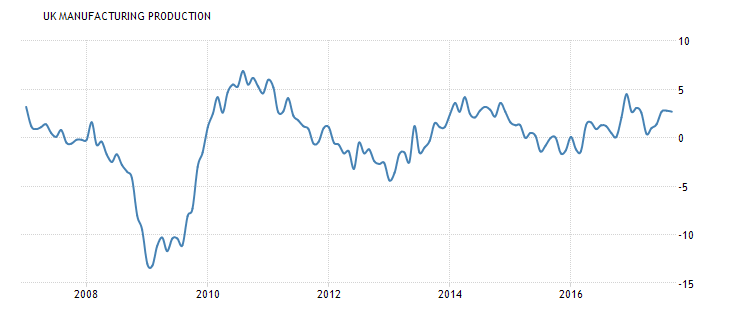The UK industrial production is expected to remain at the unchanged level over the month in October while manufacturing output is expected to decelerate to 0.1% m/m from 0.7% m/m in September, the Office for National Statistics (ONS) is set to report on Friday, December 8th.
The UK manufacturing output contracted during the most of 2017 with exception of July to September period when activity in manufacturing rose by 0.5% m/m, 0.4% m/m and 0.7% m/m respectively. Having fallen five out of nine months in 2017, the manufacturing output in the UK broadly corresponds with a general economic weakness of the UK economy a year and a half after the fatal Brexit referendum.
Forward-looking purchasing managers surveys (PMI) in manufacturing saw a solid expansion in manufacturing since the beginning of 2017, but the hard data collected from ONS rarely correspond to the overall positive tone of IHS/Markit’s PMI survey.
The manufacturing PMI for the UK picked up to 56.3 in October, up from 56.0 in September, indicating a solid rate of expansion while being above reading of 50. Even more optimistic data came n from PMI in manufacturing in November when the manufacturing activity jumped to the highest reading in last 51 months of 58.2
While October PMI data looked optimistic and the author of the PMI report Rob Dobson said that the UK manufacturing made “an impressive start to the final quarter of 2017 as increased inflows of new work encouraged firms to ramp up production”, even more, optimism was expressed in November’s PMI report.
“UK manufacturing shifted up a gear in November, with a growth of output, new orders, and employment all gathering pace. On its current course, manufacturing production is rising at a quarterly rate approaching 2%, providing a real boost to the pace of broader economic expansion” Rob Dobson, a senior economist at IHS/Markit wrote.
UK manufacturing PMI, 2008-2017

Source: IHS/Markit
So what makes the difference in ONS and survey data?
The dataset produced by the ONS and surveys like the one from IHS/Markit often differ very much, with statistical weakness on the side of surveys.
While the ONS data record exactly how much companies produce each month, the business surveys only capture whether a company’s output was higher, lower or about the same as the previous month.
The difference then stems from the height and the depth of the rises and falls in production, the business surveys measure how the rises and falls are perceived by surveyed managers in respective companies.
The second difference stems on the width of the sample. While IHS/Markit surveys about 650 companies in the UK, the ONS data are based on reports from 6,000 companies. The correlation of the hard data collected by the ONS and the faster, but less wide-spread surveys is therefore not warranted.
While the ONS data provide the most accurate assessment of manufacturing production performance, the business surveys like the one from IHS/Markit complement the picture with answers to questions about prices, employment or future business prospects.
UK manufacturing output, 2007-2017

Source: ONS
Note: All information on this page is subject to change. The use of this website constitutes acceptance of our user agreement. Please read our privacy policy and legal disclaimer. Opinions expressed at FXstreet.com are those of the individual authors and do not necessarily represent the opinion of FXstreet.com or its management. Risk Disclosure: Trading foreign exchange on margin carries a high level of risk, and may not be suitable for all investors. The high degree of leverage can work against you as well as for you. Before deciding to invest in foreign exchange you should carefully consider your investment objectives, level of experience, and risk appetite. The possibility exists that you could sustain a loss of some or all of your initial investment and therefore you should not invest money that you cannot afford to lose. You should be aware of all the risks associated with foreign exchange trading, and seek advice from an independent financial advisor if you have any doubts.
Recommended Content
Editors’ Picks
EUR/USD clings to daily gains above 1.0650

EUR/USD gained traction and turned positive on the day above 1.0650. The improvement seen in risk mood following the earlier flight to safety weighs on the US Dollar ahead of the weekend and helps the pair push higher.
GBP/USD recovers toward 1.2450 after UK Retail Sales data

GBP/USD reversed its direction and advanced to the 1.2450 area after touching a fresh multi-month low below 1.2400 in the Asian session. The positive shift seen in risk mood on easing fears over a deepening Iran-Israel conflict supports the pair.
Gold holds steady at around $2,380 following earlier spike

Gold stabilized near $2,380 after spiking above $2,400 with the immediate reaction to reports of Israel striking Iran. Meanwhile, the pullback seen in the US Treasury bond yields helps XAU/USD hold its ground.
Bitcoin Weekly Forecast: BTC post-halving rally could be partially priced in Premium

Bitcoin price shows no signs of directional bias while it holds above $60,000. The fourth BTC halving is partially priced in, according to Deutsche Bank’s research.
Week ahead – US GDP and BoJ decision on top of next week’s agenda

US GDP, core PCE and PMIs the next tests for the Dollar. Investors await BoJ for guidance about next rate hike. EU and UK PMIs, as well as Australian CPIs also on tap.